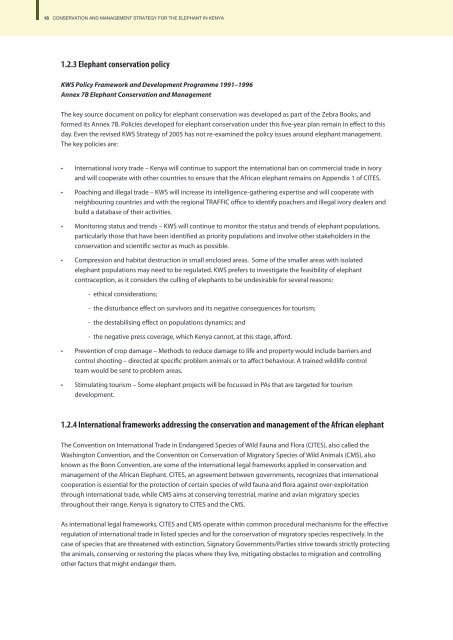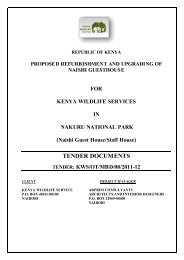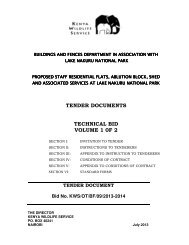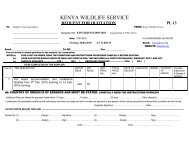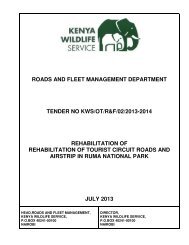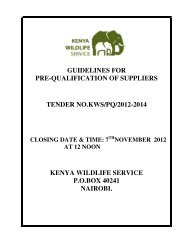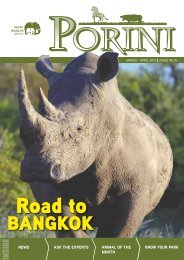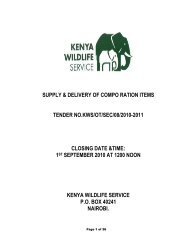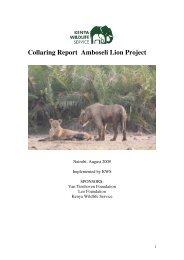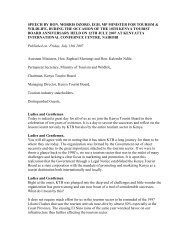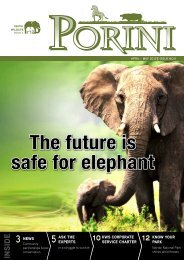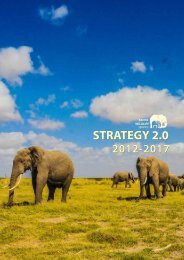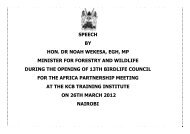Conservation and Management Strategy for the Elephant in Kenya
Conservation and Management Strategy for the Elephant in Kenya
Conservation and Management Strategy for the Elephant in Kenya
You also want an ePaper? Increase the reach of your titles
YUMPU automatically turns print PDFs into web optimized ePapers that Google loves.
18 CONSERVATION AND MANAGEMENT STRATEGY FOR THE ELEPHANT IN KENYA<br />
1.2.3 <strong>Elephant</strong> conservation policy<br />
KWS Policy Framework <strong>and</strong> Development Programme 1991–1996<br />
Annex 7B <strong>Elephant</strong> <strong>Conservation</strong> <strong>and</strong> <strong>Management</strong><br />
The key source document on policy <strong>for</strong> elephant conservation was developed as part of <strong>the</strong> Zebra Books, <strong>and</strong><br />
<strong>for</strong>med its Annex 7B. Policies developed <strong>for</strong> elephant conservation under this five-year plan rema<strong>in</strong> <strong>in</strong> effect to this<br />
day. Even <strong>the</strong> revised KWS <strong>Strategy</strong> of 2005 has not re-exam<strong>in</strong>ed <strong>the</strong> policy issues around elephant management.<br />
The key policies are:<br />
• International ivory trade – <strong>Kenya</strong> will cont<strong>in</strong>ue to support <strong>the</strong> <strong>in</strong>ternational ban on commercial trade <strong>in</strong> ivory<br />
<strong>and</strong> will cooperate with o<strong>the</strong>r countries to ensure that <strong>the</strong> African elephant rema<strong>in</strong>s on Appendix 1 of CITES.<br />
• Poach<strong>in</strong>g <strong>and</strong> illegal trade – KWS will <strong>in</strong>crease its <strong>in</strong>telligence-ga<strong>the</strong>r<strong>in</strong>g expertise <strong>and</strong> will cooperate with<br />
neighbour<strong>in</strong>g countries <strong>and</strong> with <strong>the</strong> regional TRAFFIC office to identify poachers <strong>and</strong> illegal ivory dealers <strong>and</strong><br />
build a database of <strong>the</strong>ir activities.<br />
• Monitor<strong>in</strong>g status <strong>and</strong> trends – KWS will cont<strong>in</strong>ue to monitor <strong>the</strong> status <strong>and</strong> trends of elephant populations,<br />
particularly those that have been identified as priority populations <strong>and</strong> <strong>in</strong>volve o<strong>the</strong>r stakeholders <strong>in</strong> <strong>the</strong><br />
conservation <strong>and</strong> scientific sector as much as possible.<br />
• Compression <strong>and</strong> habitat destruction <strong>in</strong> small enclosed areas. Some of <strong>the</strong> smaller areas with isolated<br />
elephant populations may need to be regulated. KWS prefers to <strong>in</strong>vestigate <strong>the</strong> feasibility of elephant<br />
contraception, as it considers <strong>the</strong> cull<strong>in</strong>g of elephants to be undesirable <strong>for</strong> several reasons:<br />
- ethical considerations;<br />
- <strong>the</strong> disturbance effect on survivors <strong>and</strong> its negative consequences <strong>for</strong> tourism;<br />
- <strong>the</strong> destabilis<strong>in</strong>g effect on populations dynamics; <strong>and</strong><br />
- <strong>the</strong> negative press coverage, which <strong>Kenya</strong> cannot, at this stage, af<strong>for</strong>d.<br />
• Prevention of crop damage – Methods to reduce damage to life <strong>and</strong> property would <strong>in</strong>clude barriers <strong>and</strong><br />
control shoot<strong>in</strong>g – directed at specific problem animals or to affect behaviour. A tra<strong>in</strong>ed wildlife control<br />
team would be sent to problem areas.<br />
• Stimulat<strong>in</strong>g tourism – Some elephant projects will be focussed <strong>in</strong> PAs that are targeted <strong>for</strong> tourism<br />
development.<br />
1.2.4 International frameworks address<strong>in</strong>g <strong>the</strong> conservation <strong>and</strong> management of <strong>the</strong> African elephant<br />
The Convention on International Trade <strong>in</strong> Endangered Species of Wild Fauna <strong>and</strong> Flora (CITES), also called <strong>the</strong><br />
Wash<strong>in</strong>gton Convention, <strong>and</strong> <strong>the</strong> Convention on <strong>Conservation</strong> of Migratory Species of Wild Animals (CMS), also<br />
known as <strong>the</strong> Bonn Convention, are some of <strong>the</strong> <strong>in</strong>ternational legal frameworks applied <strong>in</strong> conservation <strong>and</strong><br />
management of <strong>the</strong> African <strong>Elephant</strong>. CITES, an agreement between governments, recognizes that <strong>in</strong>ternational<br />
cooperation is essential <strong>for</strong> <strong>the</strong> protection of certa<strong>in</strong> species of wild fauna <strong>and</strong> flora aga<strong>in</strong>st over-exploitation<br />
through <strong>in</strong>ternational trade, while CMS aims at conserv<strong>in</strong>g terrestrial, mar<strong>in</strong>e <strong>and</strong> avian migratory species<br />
throughout <strong>the</strong>ir range. <strong>Kenya</strong> is signatory to CITES <strong>and</strong> <strong>the</strong> CMS.<br />
As <strong>in</strong>ternational legal frameworks, CITES <strong>and</strong> CMS operate with<strong>in</strong> common procedural mechanisms <strong>for</strong> <strong>the</strong> effective<br />
regulation of <strong>in</strong>ternational trade <strong>in</strong> listed species <strong>and</strong> <strong>for</strong> <strong>the</strong> conservation of migratory species respectively. In <strong>the</strong><br />
case of species that are threatened with ext<strong>in</strong>ction, Signatory Governments/Parties strive towards strictly protect<strong>in</strong>g<br />
<strong>the</strong> animals, conserv<strong>in</strong>g or restor<strong>in</strong>g <strong>the</strong> places where <strong>the</strong>y live, mitigat<strong>in</strong>g obstacles to migration <strong>and</strong> controll<strong>in</strong>g<br />
o<strong>the</strong>r factors that might endanger <strong>the</strong>m.


